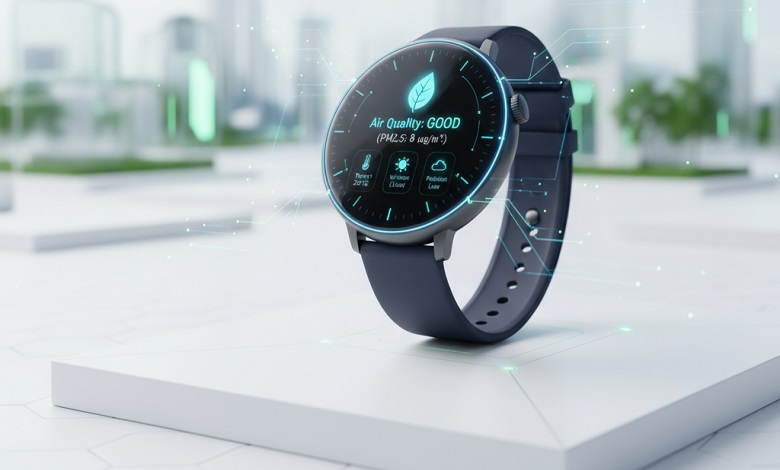Wearables have long tracked your steps, heart rate, and sleep. But the future is here: smart health-watches that also monitor your environment. From air quality to ambient light, humidity to volatile organic compounds (VOCs), these devices are adding a new layer to health tracking. In 2025, environmental data is becoming essential for wellness, especially in cities with pollution, or for those sensitive to allergens and indoor air quality. Let’s explore what these watches offer, how they compare, and whether they’ll change how you live.
🧰 What Does “Environmental Sensors” Mean in a Watch?
Environmental sensors in a watch go beyond your body’s vitals. They can include:
-
Air quality sensors (detecting CO₂, PM₂.₅, VOCs, etc.)
-
Temperature & humidity sensors
-
Barometers (air pressure)
-
Ambient light or UV sensors
-
Gas sensors for harmful pollutants
These sensors help you understand not just how you are, but what’s around you — which often influences health more than we realize (poor air can worsen sleep, stress, asthma, etc.).
✅ Key Benefits of Having Environmental Sensors
When a health watch includes environmental sensors, the advantages multiply.
-
Holistic Health Insight
You can correlate how outdoor smog levels affect your breathing, or how indoor CO₂ peaks impact your alertness and sleep quality. -
Preventive Action
Get alerts for pollutant spikes, so you can close windows, switch air filters, or avoid heavy traffic routes. -
Better Sleep & Recovery
Light pollution, humidity, and temperature are strongly linked to sleep quality. A watch that monitors these helps you optimize your sleep environment. -
Personalized Recommendations
Some watches/apps use environmental data to suggest when to go outside, when to exercise indoors, or when to hydrate more (humidity matters).
⚠️ Challenges & Things to Watch Out For
While promising, these watches aren’t flawless.
-
Sensor Accuracy: Environmental sensors are more complex to calibrate. Cheap versions may give noisy or delayed readings.
-
Battery Drain: More sensors = more power use. Continuous monitoring of air quality or VOCs tends to reduce battery life.
-
Data Overload: If the app gives too many alerts (“air quality bad”, “VOC high”, “light high”), it can stress users more than help.
-
Cost: Watches with environmental sensors tend to be in higher price tiers; plus, reliable sensors and good calibration cost more.
🔍 Examples & Emerging Models
Here are some of the watches and prototypes pushing this envelope:
-
A recent academic prototype integrates metal-oxide (MOX) gas sensors inside a smartwatch to detect common pollutants like CO, NO₂, O₃, VOCs. It uses very low-power microcontrollers and sensors to continuously monitor ambient gases and transmit via Bluetooth to a phone app. MDPI
-
Some mass-market watches already include ambient light, barometer, humidity, and temperature sensors (e.g. many models in the Amazfit line, Galaxy watches, etc.) as part of their health & fitness suites. These usually don’t go as far as detecting VOCs or dangerous gases. Savyour
-
Also emerging: wearable devices trying non-invasive sweat glucose detection using advanced sensors—while not strictly environmental, they show how sensor tech is advancing. arXiv
⚖️ Comparison: Standard vs Environmental-Aware Watches
| Feature | Standard Health Watch | Environmental-Sensor Watch |
|—|—|—|
| Core health tracking (HR, SpO₂, sleep) | ✓ | ✓ |
| Light/humidity/pressure sensors | Often basic | More advanced & sensitive |
| Air quality / VOCs / gas detection | Rare / none | Included in higher-end / prototype models |
| Battery usage | Moderate | Higher demand |
| Use cases | Fitness, wellness | Wellness + environmental health (pollution, sleep optimization, allergies) |
Even though I’m giving this in a list form for clarity, the real distinction is not in features yes/no, but in how well these environmental sensors are integrated and used.
💡 Who Should Consider These Watches?
This kind of technology is especially valuable for:
-
City dwellers in polluted or smoggy areas.
-
Asthma or allergy sufferers.
-
Those interested in sleep hacking or optimizing recovery.
-
Environmental activists or people tracking outdoor exposure.
-
Tech-enthusiasts who want next-gen wearable features.
If your priority is flashy apps, music, or fashion, a standard smartwatch may suffice. But if environmental health matters to you, the newer sensor sets are worth exploring.
🔁 Subscription Models & Apps
Many of these environmental-sensor watches pair with companion apps or subscription services to unlock full value:
-
Continuous data storage & cloud sync so your environmental readings build up into long-term trends.
-
Alerts or reports (e.g. weekly “your exposure to VOCs was high on Tuesday afternoons”) which often require premium tiers.
-
Some apps integrate with smart home gear (air purifiers, thermostats) to automatically respond (e.g., turn on an air purifier when VOC or PM₂.₅ is high).
Before buying, check whether all key environmental features are included in the base price or locked behind subscription walls.
🛒 Product Mentions & What to Look for
Here are a few products / prototypes to keep on your radar, and what makes them stand out:
-
Prototype MOX-sensor watch (academic model) – strong in gas detection, promising for future commercial versions. MDPI
-
Amazfit & Samsung Galaxy series – often include sensors like ambient light, barometer, temperature; solid for mid-range users. Savyour
-
Something like the Lenovo Watch S for more basic environmental sensors with better price point. Wikipedia
When shopping, examine:
-
Which specific environmental sensors are included (VOC, gas, PM₂.₅, etc.).
-
Accuracy certifications (if any).
-
Battery life with environmental monitoring turned on.
-
Quality of companion app and whether alerts are customizable.
🌟 Final Thoughts: Is the Extra Worth It?
Smart watches with environmental sensors are evolving from novelty to necessity. In 2025, as global pollution, indoor air quality, and environmental health gain attention, wearable tech is rising to meet that demand.
If you care about more than just steps — if you want to know when the air you breathe truly starts affecting you, or how the room conditions might be reducing your sleep or recovery — then investing in a watch with good environmental sensors could be transformative.
But if your budget is tight, or you’re using wearables mainly for basic fitness tracking, you might prefer watching this space, waiting until more polished and affordable models arrive.















